Some of our native plants are in danger of being eliminated not by humans, or encroaching structural development, but by non-native species which are brought here as ornamental plants, or as ground cover, etc. Some of these imported plants grow extremely well here, spread aggressively, and have no natural predators. Often it takes a while for animals and bugs to learn that an imported plant is tasty. Sometimes the invader makes effective compounds to deter the local predators, and even prohibit the growth of other plants nearby. Some of them make fungicides which interrupt the vast mycorrhyzal array which helps to make nutrients available to plants, thereby inhibiting the competitive growth indirectly.
Surrounding Weedom are numerous smart neighbors who are well versed in the ways of the natural world, and they add volumes to the repository of weed information available to be turned over to our readers. So many of them have an personal formulary of weeds that they regularly use for food and self care. We have been encountering more of these skillful people as we promote this project.
It’s Garlic Mustard Week, and as a bonus we’ll help you avoid nasty trouble from a onion grass look-a-like.
Newsletter readers, go ahead and visit the web page and click on the gallery pictures to see bigger versions, if you want more detail. (Clicking on any button usually directs you to the web page.)
Garlic mustard, Alliaria petiolata is a biennial member of the family Brassicaceae, which includes mustards. Those 4 petal flowers, seen below, are the hallmark blooms of this family. This weed originates in Europe and parts of Asia, and has proven to be a most successful and aggressive import.
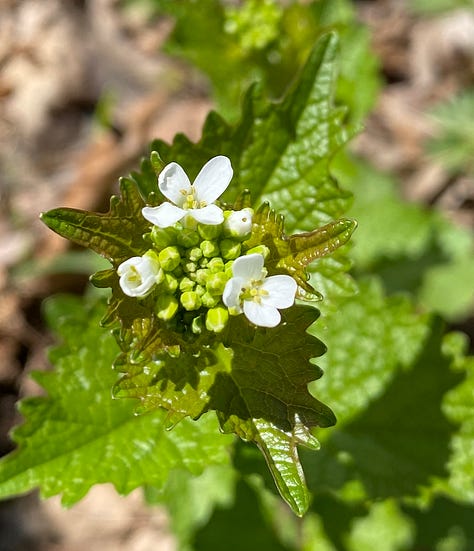

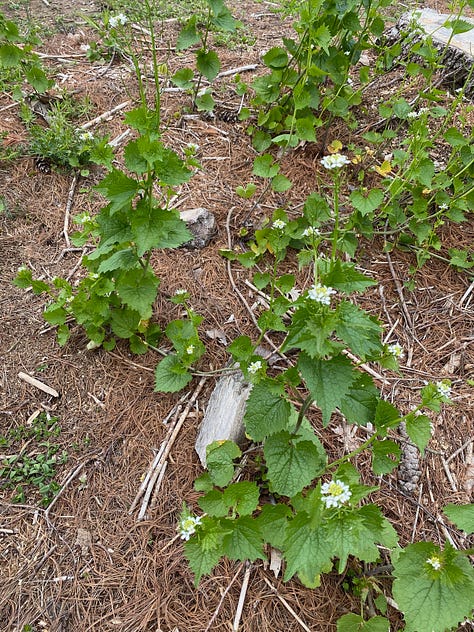
In zone 6, much of the garlic mustard has bloomed, but we can still find some of the early, first year rosettes which seem to pop up when cool weather rolls in. Leaves of these rosettes are up to 2 inches wide and 2 or 3 inches long, and extend directly from the base. They’re a bit difficult to differentiate from violets sometimes but feel more rough. The stiffness and texture of the leaves, as well as the mild garlic taste are telltale signs. In the second year a stem shoots up which might reach 2 or more feet in height in the sun, but tends to be much shorter in the shade. Flowers occur in bunches at the tips, and as these grow upward, seed pods called siliqua form along the stem. Those are visible in the middle picture above. Mature seeds become dark or black later in the season.
In order to control this invasive weed, you can pull them while they’re young, and eat them up, or yank the second year plants before the seeds form. Like numerous other edible members of this family, don’t eat them by the bale. They do contain some cyanogenic compounds, as do thousands of other plants, parts of which people eat regularly. Many foragers recommend cooking the older plants for palatability. Flowers and the leaves near them tend to be less palatable. The flavor of the leaves varies among the populations of garlic mustard, and the age of the plant. This spring, we found the young leaves to be quite mild, and the upper leaves of the flowering plants to be not so good. Vitamin A and C are significant nutrients found in garlic mustard. A collection of garlic mustard recipes awaits you at HealthygreenSavvy where they use the entire plant. We’re inclined to skip the uppermost part at weedom on account of flavor. This weed is amenable for use in pesto and in dips, but can be mixed in with any greens.
Among traditional uses of this particular mustard weed are as an antimicrobial topically for wounds, internally as a diuretic, expectorant, to address vitamin C deficiency, to stimulate digestion, and to clear obstructions.



Benzyl isothiocyanates found in roots of garlic mustard have been credited with ability to inhibit various fungi, and in limited fashion inhibit the ectomycorrhyza and arbuscular mycorrhyza that live symbiotically with roots of certain trees and plants. This could affect especially the ability of seedlings to survive, as their roots are shallow, and in range of the garlic mustard roots. These mycorrhyza are groups of various fungi that can surround and even enter the roots of plants. The roots and fungi supply each other with needed nutrients. Messing with the fungi could inhibit the growth of the plants that are dependent upon the fungal relationships. This has been considered a significant mechanism of allelopathy, the chemical process by which certain plants can inhibit the growth of competing plants. Not only are foreign invading plants capable of this, but many native plants seem to have similar effects, for example Jewelweed (Impatiens capensis). A 2016 review of the allelopathic ability of garlic mustard by Cipollini suggests that perhaps nutritional depletion is a more dominant mechanism for inhibiting the growth of competitors, and even successive plantings of the weed itself. More influence on mycorrhyza which support plant growth seemed to occur in soils which had not been previously exposed to the garlic mustard. Over time, the soil fungi seemed to become less influenced or less sensitive to the chemicals produced by garlic mustard.
Like Wintercress, garlic mustard has the ability to attract certain insects such as Pieris virginiensis, the virginia white butterfly to lay eggs on the plant, only to later kill off the larvae. Alliarinoside is the compound credited for this larvicidal effect.
Our first “Do Not Eat”:
The Star of Bethlehem, Ornithogalum umbellatum, said to be synonymous with O. thyroides, has been moved from the family liliaceae, to the family hyacynthaceae, which was renamed the asparagaceae. Lots of graduate degrees were likely conferred in this process. It makes tracking the research ridiculous. Now that you gagged on this info, make sure you don’t confuse it for “onion grass”, Allium Canadense or wild garlic, Allium vineale or you will do worse than gag . T.S., who wages local war on the invasive plants, tells the story of her cat, who thought he was hitting some kind of kitty grass. He took a bite and immediately spat out this Star of Bethlehem. This alerted her to a huge colony of the stuff, creeping in from the neighboring farm. This plant has escaped from the flower gardens everywhere, and is aggressively taking over in numerous areas within zones 4-8.
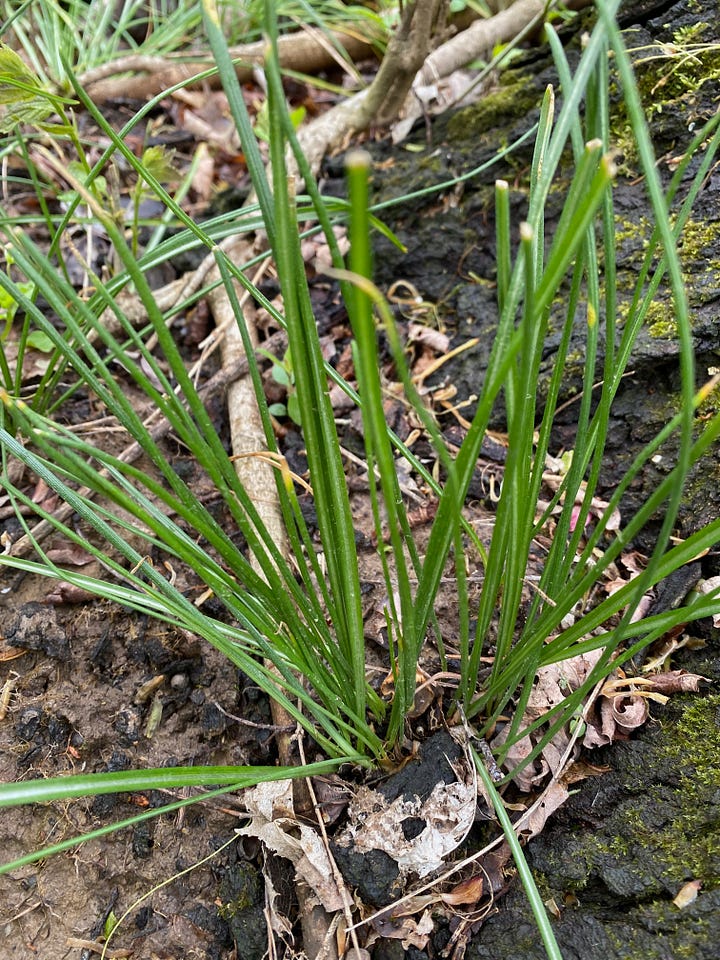
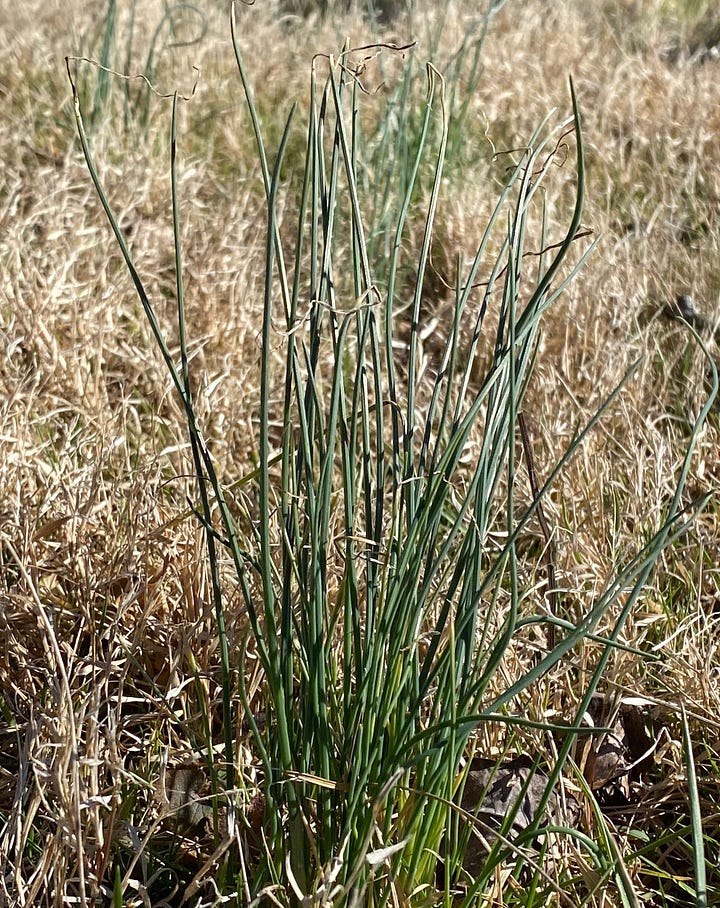
We’ll save you some trouble by distinguishing star of Bethlehem from onion grass, so you don’t get a taste of convallotoxin types of cardiac glycosides, which have some digitalis-like characteristics. Digitalis is one of those plant-derived heart drugs, dosed in tiny quantities, that have to be monitored with levels from time to time, and a specific, expensive antidote called DigiFab was created for those who are brought to the hospital with toxic levels of the drug. It’s been used for poisonings with plant derived cardiac glycosides too. Though there exist herbalists who employ Star of Bethlehem, and it is under study for numerous purposes, we do not recommend using this for food when you pull it. It’s not worth the trouble. Don’t drop it in a normal compost pile. The bulbs are pretty persistent, and you should consider baking them in the hot sun, then disposing of them in the trash, wherever you don’t have permission to burn them.
Notice the angular leaves of star of Bethlehem and the white vein in the center of each leaf. This distinguishes it from wild garlic, which has round hollow leaves. Wild Onion has leaves which are not hollow. Both wild garlic and wild onions have a distinctive smell, which star of Bethlehem lacks. A group of flower buds is forming in the picture below. They will be white with six petals. The bulbs on the star of Bethlehem seem a little more translucent looking than those of wild onions, but are about the same size.
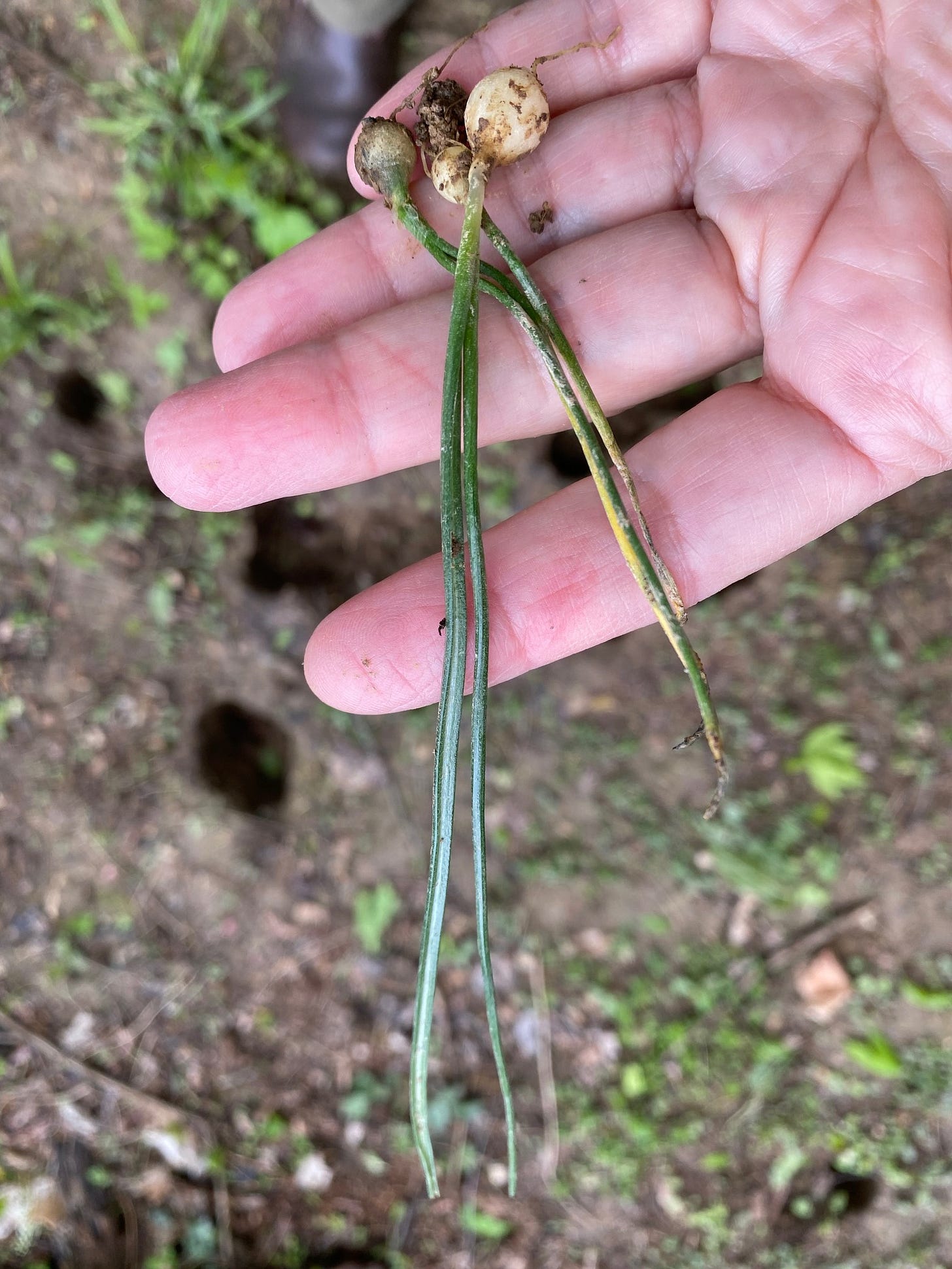
A similarly toxic landscape flower, lily of the valley, (Convallaria majalis) puts out a related array of cardiac toxins, but it spreads much less aggressively than Star of Bethlehem.
It’s a great idea to keep little teething kids, (who might chew anything), livestock, labradors, and cats away from this weed, as well as Star of Bethlehem.
We’re thinking of presenting the medicinal weed, Galium aparine (cleavers or goose grass) next. What do you think? Tell us what’s growing. Have you found another invasive plant that we should show people how to use?
Where We Dig
1. Susannah. 16 Garlic Mustard Recipes & Uses for Garlic Mustard Plant. Published May 27, 2022. Accessed May 3, 2023. https://www.healthygreensavvy.com/garlic-mustard-recipes-plant/
2. Cipollini D. A review of garlic mustard (Alliaria petiolata, Brassicaceae) as an allelopathic plant. tbot. 2016;143(4):339-348. doi:10.3159/TORREY-D-15-00059
3. Vaughn SF, Berhow MA. Allelochemicals Isolated from Tissues of the Invasive Weed Garlic Mustard (Alliaria petiolata). J Chem Ecol. 1999;25(11):2495-2504. doi:10.1023/A:1020874124645
4. Rahman M, Khatun A, Liu L, Barkla BJ. Brassicaceae Mustards: Traditional and Agronomic Uses in Australia and New Zealand. Molecules. 2018;23(1):231. doi:10.3390/molecules23010231
5. Cipollini D, Gruner B. Cyanide in the chemical arsenal of garlic mustard, Alliaria petiolata. J Chem Ecol. 2007;33(1):85-94. doi:10.1007/s10886-006-9205-x
6. Davis SL, Frisch T, Bjarnholt N, Cipollini D. How Does Garlic Mustard Lure and Kill the West Virginia White Butterfly? J Chem Ecol. 2015;41(10):948-955. doi:10.1007/s10886-015-0633-3
7. How to Forage for Garlic Mustard & Make Garlic Mustard Pesto. Accessed May 3, 2023. https://abetterwaytothrive.com/foraging-for-garlic-mustard-plus-garlic-mustard-pesto-recipe/
8. https://www.facebook.com/thespruceofficial. How to Identify and Control Highly Invasive Garlic Mustard. The Spruce. Accessed May 2, 2023. https://www.thespruce.com/garlic-mustard-plant-profile-invasiveness-and-identification-5082020
9. How to Identify Garlic Mustard — Foraging for Edible Wild Greens. Sycamore Garden Plant Database. Published May 23, 2017. Accessed April 28, 2023. https://foraging.sycamore.garden/plants/edible-wild-garlic-mustard
10. Slenter IJM, Djajadiningrat-Laanen SC, de Vries I, Dijkman MA. Intoxication with Ornithogalum arabicum is a potential cause of visual impairment and irreversible blindness in dogs. Toxicon: X. 2019;4:100014. doi:10.1016/j.toxcx.2019.100014
11. Jewelweed - Impatiens Capensis: Edible & Medicinal Uses of the Snappiest Wild Plant - Song of the Woods. Accessed May 2, 2023. https://www.songofthewoods.com/jewelweed-impatiens-capensis/
12. Grieve M. Modern Herbal. Echo Point Books & Media, LLC.; 2015. https://openlibrary.org/books/OL36722889M/Modern_Herbal
13. Ornithogalum (Cape Hyacinth, Spire Lily, Star of Bethlehem, Summer Hyacinth) | North Carolina Extension Gardener Plant Toolbox. Accessed May 2, 2023. https://plants.ces.ncsu.edu/plants/ornithogalum/
14. Ornithogalum thyrsoides (Ornithogalum, Star-of-Bethlehem) | North Carolina Extension Gardener Plant Toolbox. Accessed May 2, 2023. https://plants.ces.ncsu.edu/plants/ornithogalum-thyrsoides/
15. Ornithogalum umbellatum Star Of Bethlehem, Dove’s Dung PFAF Plant Database. Accessed May 1, 2023. https://pfaf.org/user/Plant.aspx?LatinName=Ornithogalum+umbellatum
16. Plančić M, Božin B, Kladar N, Rat M, Srđenović B. Phytochemical profile and biological activities of the genus Ornithogalum L. (Hyacinthaceae). Biologia Serbica. 2015;36(1-2). Accessed May 1, 2023. https://ojs.pmf.uns.ac.rs/index.php/dbe_serbica/article/view/2421
17. Fink SL, Robey TE, Tarabar AF, Hodsdon ME. Rapid Detection of Convallatoxin Using Five Digoxin Immunoassays. Clin Toxicol (Phila). 2014;52(7):659-663. doi:10.3109/15563650.2014.932366
18. Star of Bethlehem | Missouri Department of Conservation. Accessed May 1, 2023. https://mdc.mo.gov/discover-nature/field-guide/star-bethlehem
19. LLC P. Star of Bethlehem | PoultryDVM Toxic Plants A-Z. PoultryDVM. Accessed May 1, 2023. http://www.chickendvm.com/poisonous/star-of-bethleham
20. Star-of-Bethlehem (Ornithogalum umbellatum). Accessed May 3, 2023. http://www.illinoiswildflowers.info/weeds/plants/starbeth.htm
21. Wolfe BE, Rodgers VL, Stinson KA, Pringle A. The invasive plant Alliaria petiolata (garlic mustard) inhibits ectomycorrhizal fungi in its introduced range. Journal of Ecology. 2008;96(4):777-783. doi:10.1111/j.1365-2745.2008.01389.x





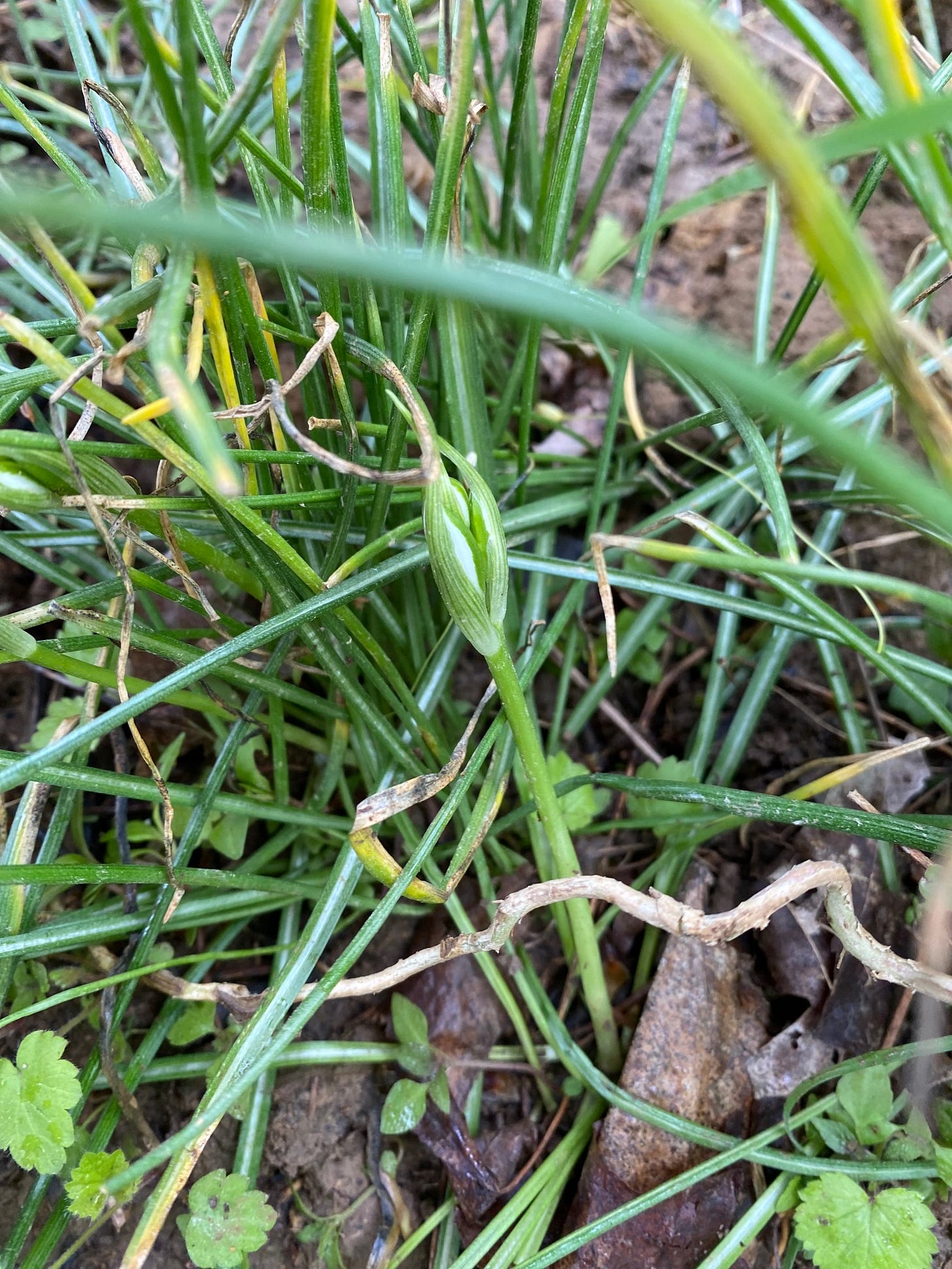
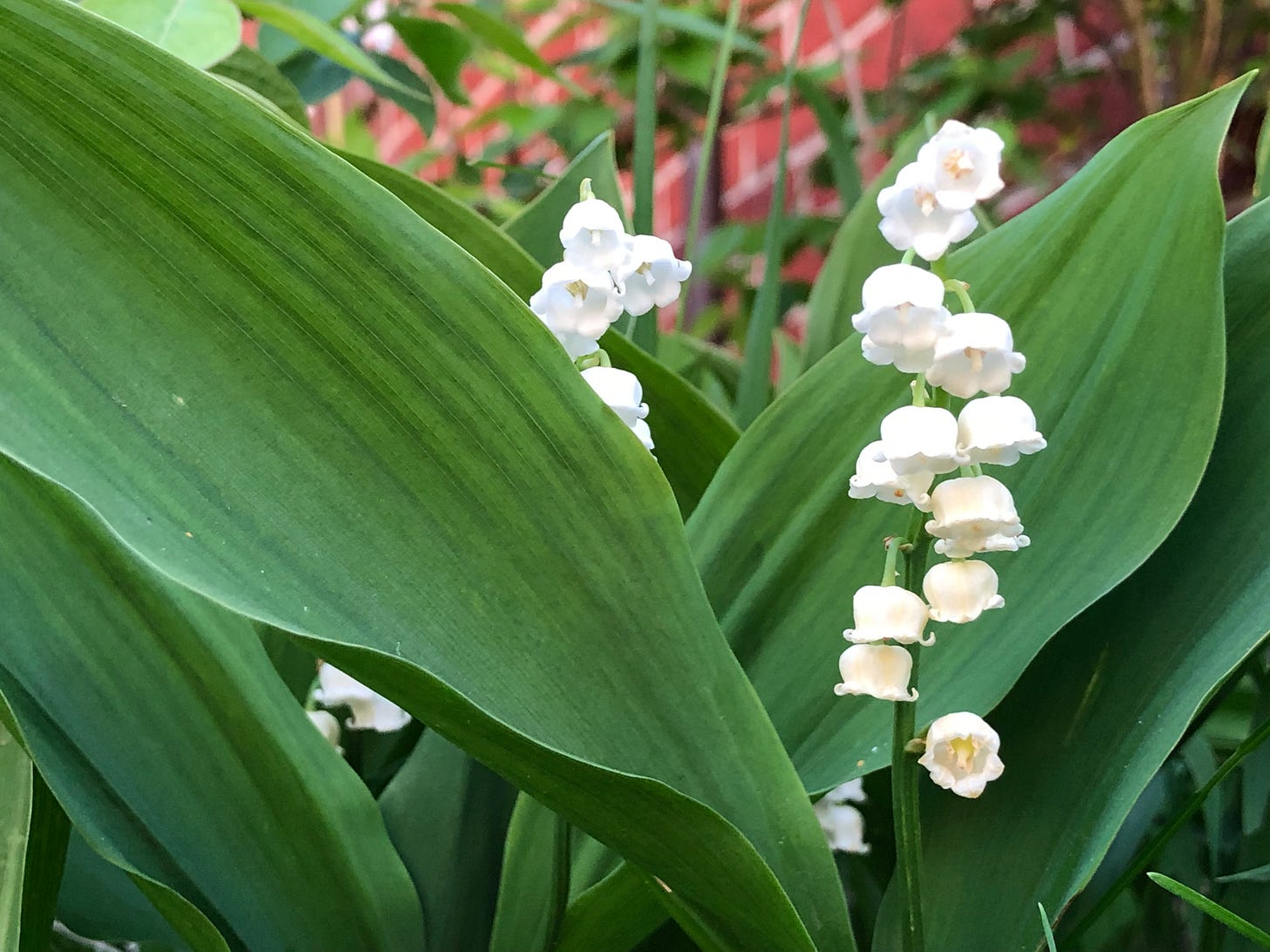
Not sure if we have these in Aus. Havent seen any of them around at all.
Garlic Mustard is one of my favorite wild edibles... so much so that I have been tempted to plant it. But, I haven't for the reasons you mentioned. I don't know... I may transplant some into some containers someday.